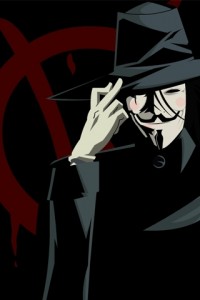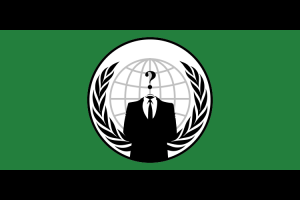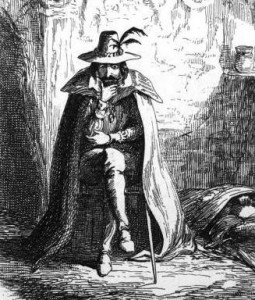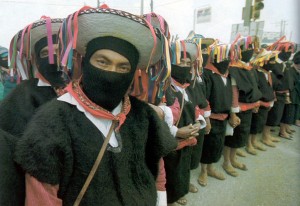 An article by Jonathan Jones in the Guardian has been making the rounds and offers some interesting commentary on the proliferation of the V for Vendetta mask at recent #Occupy protests. Coming on the heels of the Oakland General Strike, the piece got me thinking about a few things: other histories and examples of masked protest, the role of clandestine or anonymous activism, violence, and the destruction of property. Considering the name of this blog, I couldn’t pass up the chance to share some really scattered thoughts about these political masquerades.
An article by Jonathan Jones in the Guardian has been making the rounds and offers some interesting commentary on the proliferation of the V for Vendetta mask at recent #Occupy protests. Coming on the heels of the Oakland General Strike, the piece got me thinking about a few things: other histories and examples of masked protest, the role of clandestine or anonymous activism, violence, and the destruction of property. Considering the name of this blog, I couldn’t pass up the chance to share some really scattered thoughts about these political masquerades.
In the Guardian, Jones notes how the face of Guy Fawkes, a militant Catholic mercenary involved in the 1605 Gun Powder Plot to blow up the parliament, has now become an international symbol of “dissidence and defiance.” The original Fawkes, discovered guarding 36 barrels of gunpowder wedged under parliament, was newly immortalized by the hugely popular V for Vendetta film based on the comics illustrated by David Lloyd and written by Alan Moore.
The film depicts a post-apocalyptic England that has been taken over by a totalitarian fascist dictatorship that uses fear over a virus emitted by “terrorists” (really it’s the government) to bludgeon the population. The protagonist is a vigilante called “V,” a rogue insurrectionist and propagandist trying to bring down the government and awaken the people from their cowering slumber.
He becomes an underground sensation and through his engineered spectacles and the people begin to shed their fear and start wearing the same Guy Fawkes mask that adorns V’s mug. Spoiler alert! In the final scenes, V’s plan finally succeeds and parliament is blown up on November 5, bringing down the fascist regime. Rallying to the cause, the masses show up wearing the mask, lifting it only to watch the exploding fireworks of parliament’s fiery inferno.
Masks & Anonymity: We Are Everyone, We Are Everywhere
 As the Guardian piece notes, the global hacktivist network Anonymous has appropriated the comic book’s stylized Guy Fawkes mask, which has now become increasingly present at #Occupy protests. For Anonymous, the mask represents their subversive V-like anti-establishment bent. But what the mask really represents in the context of the cyber-activist group is its anonymous, ubiquitous, networked, and acephalous political culture.
As the Guardian piece notes, the global hacktivist network Anonymous has appropriated the comic book’s stylized Guy Fawkes mask, which has now become increasingly present at #Occupy protests. For Anonymous, the mask represents their subversive V-like anti-establishment bent. But what the mask really represents in the context of the cyber-activist group is its anonymous, ubiquitous, networked, and acephalous political culture.
The identity of “Anonymous” is itself habitable by anyone who chooses to do so. The mask itself symbolizes that the “we” is everyone and the “where” is everywhere. That’s the point of the final scenes of the V film in which the English crowd realizes that they are all V, the power to rise up resides in all of them. Let us not forget that masked protest has a long history in English history.
Masks & Private Property: Seek and Destroy?
 In 1723, the House of Commons—still standing thanks to the foiled Gun Powder Plot—passed the Waltham Black Act. The Black Acts were draconian measures adopted to punish those who were transgressing the bounds of private property created by the enclosures of common lands. The laws took aim at those “armed with swords, firearms, and other offensive weapons, several of them with their faces blacked, or in disguised habits” (qtd. in Thompson 1974:270). Prevented from sustaining their families by hunting deer, fishing, and collecting wood on the newly privatized lands, displaced commoners began poaching what Karl Marx would later call the “alms of nature.”
In 1723, the House of Commons—still standing thanks to the foiled Gun Powder Plot—passed the Waltham Black Act. The Black Acts were draconian measures adopted to punish those who were transgressing the bounds of private property created by the enclosures of common lands. The laws took aim at those “armed with swords, firearms, and other offensive weapons, several of them with their faces blacked, or in disguised habits” (qtd. in Thompson 1974:270). Prevented from sustaining their families by hunting deer, fishing, and collecting wood on the newly privatized lands, displaced commoners began poaching what Karl Marx would later call the “alms of nature.”
They acted at night and often blackened their face with soot or gunpowder to protect their identities—hence, the “Black Acts.” Destroying his majesty’s infrastructures for protecting private property, they called themselves “turnpike cutters” or “levellers” (Thompson 1974:256). Blackening your face or covering it up became a crime in itself.
When masked, black-clad activists at Oakland’s General Strike on November 3 began destroying property at a Whole Foods, protestors who did not agree with this tactic began admonishing the blackened protestors—in some cases, physically tackling them to prevent the destruction. In a video posted online (start at min. 6:12 below) that was apparently shot by a blackened protestor, a peaceful protestor yells at the cameraperson, “Who are you hiding from!? Who are you!? Show your fucking face!”
[youtube_sc url=”http://youtu.be/ZqYM_fNsndA?t=6m12s”]
The destructive and confrontational tactics of blackened protestor on November 3 in Oakland has sparked a lively debate around property destruction and around responding to police violence in kind. In comments made during Oakland’s General Assembly some people specifically objected to the clandestine nature of some factions and called against covering faces. I think questioning confrontational tactics is an important debate; not so much in terms of whether such actions are legitimate, but rather in terms of how it paints the larger body of protests and how some actions have put the #Occupy camp itself at risk.
Being Masked in Order to Be Seen
 One group that has not shunned violence and made black masks part of their political culture is Mexico’s Ejército Zapatista de Liberación Nacional (EZLN). When they burst onto the global scene on New Year’s Day in 1994, they were asked why they covered their faces. In what’s now classic Zapatista style they responded, “With our faces exposed we were invisible. We cover our faces in order to be seen.” Is Guy Fawkes letting us be seen? Are blackened Oakland protestors letting us be seen?
One group that has not shunned violence and made black masks part of their political culture is Mexico’s Ejército Zapatista de Liberación Nacional (EZLN). When they burst onto the global scene on New Year’s Day in 1994, they were asked why they covered their faces. In what’s now classic Zapatista style they responded, “With our faces exposed we were invisible. We cover our faces in order to be seen.” Is Guy Fawkes letting us be seen? Are blackened Oakland protestors letting us be seen?
The Zapatistas’ called themselves the “sin rostro”—the faceless. The black ski mask was a powerful statement of not only of their collective being, but also a collective gesture to all of Mexico’s “forgotten ones” (los olvidados) and those on the receiving end of what they called the Fourth World War (i.e. neoliberalism—World War III, being the “cold” war). An excerpt from one of the famed communiqués:
Behind our black mask,
Behind our armed voice,
Behind our unnameable name,
Behind us, who you see,
Behind us, we are you.Behind we are the same simple and humble men and women,
who are repeated in all races,
painted in all colors,
speak in all languages
and live in all places.
The same forgotten men and women.The same excluded,
The same untolerated,
The same persecuted,
We are you.—The Indigenous Clandestine Revolutionary Committee, General Command of the EZLN

Pingback: More on the Guy Fawkes mask | Progressive Geographies
Pingback: STUART ELDEN “V for Visibility” « Society and Space – Environment and Planning D
Pingback: Occupy on Fiber Optics | Territorial Masquerades
Thanks for the heads-up on the Guardian piece and for this. I’m teaching a class on the histories of anarchism next semester and have been thinking about the pros and cons of opening the semester with, among other things, this film. Interesting piece too by Elden. Thanks! Ray
Pingback: The Politics of Anonymous | Territorial Masquerades